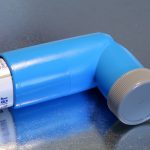 I guess Santa doesn’t have asthma, since in all likelihood he would have missed some Christmases given the rates of exacerbation for asthma during the fall and winter. Santa would especially be vulnerable during this worse time of year for most asthmatics since he rides around on a sleigh in frigid arctic air and climbs down a smoke-filled chimney. He also laughs a lot (ho-ho-ho). When we laugh (or cry) we breathe in and out rapidly, and our lung airways cool off and cooling of the airways causes asthma. That being said, let’s discuss what the average asthma patient can do to prevent exacerbating their asthma during the fall and winter.
I guess Santa doesn’t have asthma, since in all likelihood he would have missed some Christmases given the rates of exacerbation for asthma during the fall and winter. Santa would especially be vulnerable during this worse time of year for most asthmatics since he rides around on a sleigh in frigid arctic air and climbs down a smoke-filled chimney. He also laughs a lot (ho-ho-ho). When we laugh (or cry) we breathe in and out rapidly, and our lung airways cool off and cooling of the airways causes asthma. That being said, let’s discuss what the average asthma patient can do to prevent exacerbating their asthma during the fall and winter.
Before we begin, keep in mind that if your asthma is well controlled and/or you are on the appropriate level of controller medications, then you should mostly be fine. There also is a role of the rescue inhaler in preventing some of these triggers, but this should be discussed with the physician who takes care of your asthma. I cannot emphasize enough the need to be clear about the role of your controller medications and rescue inhalers.
On to the cool weather triggers:
Trigger 1: Cold Air
Cooling of the airways of the lung results in bronchoconstriction (narrowing), which leads to shortness of breath and wheezing.
Cold Air Strategies
* Try to avoid real frigid cold air as much as possible, or cover your nose and mouth with a scarf.
* Avoid exercising outdoors in cold air, unless your physician feels your asthma is adequately controlled. Your doctor may recommend you use a rescue inhaler prior to exercise in cold air. But this decision rests with your doctor.
* Keep your rescue inhaler with you whenever you are outside, in any season.
Trigger 2: Indoor Smoke and Fumes
Fumes and odors can trigger asthma (especially if the asthma is not well controlled).
Smoke and Fume Strategies
The fumes and odors peculiar to this season that should be avoided include:
* Fireplace smoke.
* Woodstove smoke. While not common in New York City, a lot of country folks heat their homes with woodstoves. They require frequent loading of wood and a lot of fumes escape. If you are visiting relatives over the holidays, you may encounter this.
* Indoor smokers.
* Odors from indoor plants, including Christmas trees. Probably the fake trees are a better option if there is a poorly controlled asthmatic in the house.
* Visitors wearing perfumes and bringing flowering plants and candles all can trigger asthma in the sensitive or poorly controlled asthmatic.
Trigger 3: Indoor Allergens
Indoor allergens are a little trickier than the others as they first have to be identified as a problem, which would require consultation with an allergy specialist and involve some sort of testing to confirm a suspicion. I will list the possible allergens but another blog post will deal with them in more detail.
Indoor Allergen Strategies
* Pets. Short of getting rid of them, which is not a realistic option for most people, you might opt for less drastic measures such as keeping pets out of the bedroom, making where you sleep a “pet-free” zone in the house.
* Cockroaches. Use extermination to keep the allergen levels as low as possible.
* Dust mites. Mite-proof encasings for the bedding can significantly reduce exposure to dust mite allergens.
* Mice can be an issue in both urban and suburban homes.
Trigger 4: Viral Infections
Viruses are one of the main causes of asthma exacerbations requiring emergency treatments. We are all familiar with the symptoms of a viral infection, which include sore throat, runny nose, fever, headache and cough. Influenza is but one of many viruses that cause illness in the fall and winter. The diagnosis of influenza can only be confirmed by blood tests, but usually a presumptive diagnosis is all that is necessary.
Viral Infections Strategies
* Asthmatics should get the annual flu shot to prevent influenza, which is a more severe disease in people with asthma.
* Always wash your hands thoroughly and appropriately. Use hand sanitizer if you cannot get to running water and soap.
* Avoid exposures to large numbers of people if possible.
* Take good care of your body through proper diet, sleep and exercise, all of which contribute to a healthy immune system.
Best Overall Strategy: Use Your Controller Medication!
When I first went into practice taking care of asthmatics in the mid-1980s, I was truly struck by just how busy my office became in October and November. After inhaled steroids and other asthma controller medications were invented, this pattern changed, and there is no longer this extreme seasonal fluctuation in the fall. This only serves to emphasize how important controller medications are in maintaining your asthma in good control in the fall and winter.
Wishing everyone a happy and healthy holiday season!
Bruce S. Dobozin, MD, is an Allergist at Beth Israel Medical Center.
